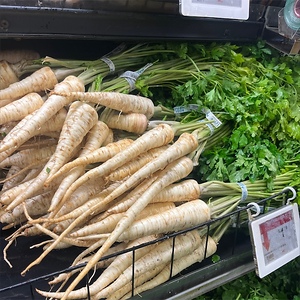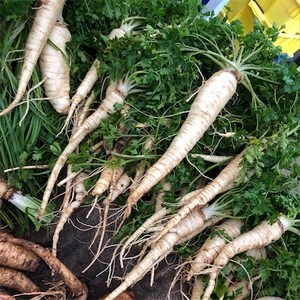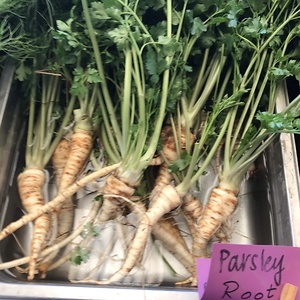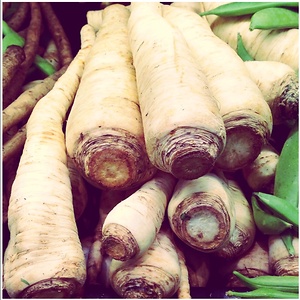

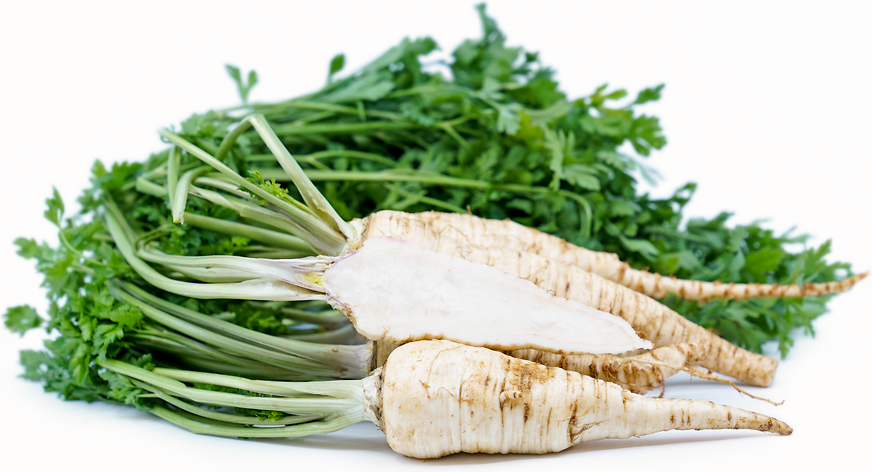
Parsley Root
Estimated Inventory, 12 ct : 0
This item was last sold on : 12/20/23
Description/Taste
Parsley root looks deceivingly like a parsnip with its tapered shape, light beige skin, and roughened with furrowed textures. The root can grow up to six inches long with a diameter of two inches or so; it is sometimes found double-rooted. Parsley root has a crisp, yet tender texture when raw and a smooth and creamy texture once cooked. The taste of Parsley root is likened to a combination of celeriac, parsley and carrot. The tuber is very aromatic and is sometimes used as an herb. The entire Parsley plant, roots and greens, is edible.
Seasons/Availability
Parsley root is available year-round with a peak season during the winter and spring months.
Current Facts
Parsley root is botanically known as Petroselinum crispum var. tuberosum. The particular variety of parsley grown for its taproot is called Hamburg Parsley, named for the place it is believed to have originated. It is also commonly known as Rooted Parsley and Dutch Parsley. Though it has similarly-shaped leaves, it should not be confused with Italian flat leaf parsley nor the common curly variety, as neither of these produce edible roots.
Nutritional Value
Parsley root is high in vitamin C and iron, and also has high levels of sodium.
Applications
Parsley root is often prepared with other root vegetables like turnips, parsnips, and carrots and can be substituted in recipes calling for any of those items. Parsley root is generally cooked before eating, but it can also be served raw in slaws, salads or on a crudité platter. The root should be peeled before use. Slice Parsley root into thin rounds and fry for chips or grate and make into fritters. Roast or boil Parsley root to soften and puree for soups and sauces, or combine one part Parsley root with three parts boiled potatoes for a twist on traditional mashed potatoes. Parsley root can be paired with lamb, poultry, cabbage, horseradish, thyme, sweet potato, shallots and hearty grains. Chopped Parsley root can be added to soups and stews for an aromatic addition. Though this particular variety of Parsley is grown for its root, the leaves can also be used as a fresh garnish or as a flavoring herb in soups and stews; use as you would in any recipe for fresh Parsley. If you intend to use the greens as well, separate them from the root to store. When refrigerated, Parsley root will keep for about two to three weeks, longer than the greens, which only keep for about a week.
Ethnic/Cultural Info
Parsley root is popular in Central European cuisines. In Germany, Parsley root is included among herbs and vegetables known as suppengrun or soup greens that are combined with chicken or beef and cooked for soups or sauces.
Geography/History
Parsley root first appeared in a Dutch cookbook written in the second half of the 15th century, and translated by Constant Antoine Serrure of Belgium in 1892. In the manuscript, Parsley root appears as the main ingredient in one recipe for vegetable stew. Parsley root also appeared in a cookbook in Hamburg, Germany in the 16th century. Since that time, the root was more common in recipes throughout Russia, Poland, and Germany. Though cultivated varieties are grown throughout the Northern Hemisphere in both the New and Old World, Parsley root remains commercially relevant as a culinary crop primarily in Central and Eastern Europe. The tuber can be found in markets catering to predominantly Polish, Jewish and German populations.
Recipe Ideas
Recipes that include Parsley Root. One



